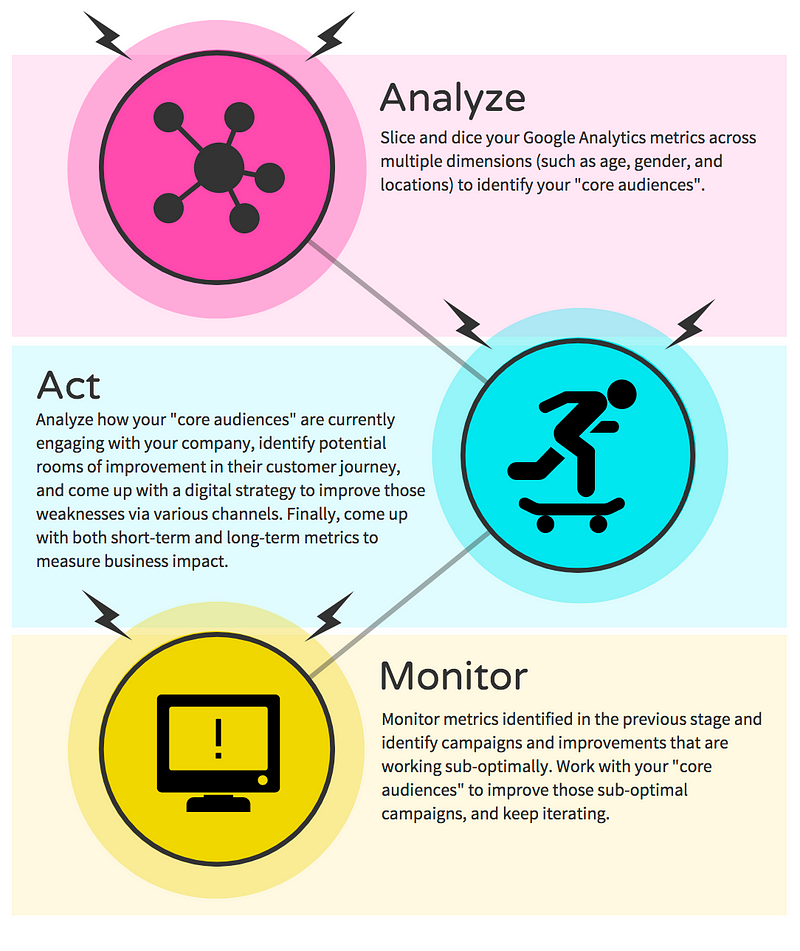Conversion Optimization: 3 Simple Steps to Improve Your Conversion Rate Using Google Analytics

All websites are created for a purpose. They can make your customers more aware of your brand, encourage them to buy your product, or push them to visit your storefront.
The effectiveness of your website in accomplishing these various objectives can be summarized in one metric — conversion rate.
Your conversion rate is a measure of how effectively your website is able to accomplish the purpose it was designed for. As such, everything about your website should be geared towards optimizing your conversion rate..
However, tracking and optimizing your conversion rate in the real world is often like using a lighthouse as a landmark when sailing on a dark and stormy night — while you might know where you are going in general, it is still difficult to chart a course that will get you to your destination safely.
Luckily, free tools like Google Analytics can serve as a compass that guide you through the complex stormy sea of digital marketing. In other words, it’ll help you accomplish your business objectives and by safely leading you through the night.
For this reason, we spent the last couple of months touching on each of the aspects of Google Analytics in an attempt to help leverage your business to the greatest extent possible.
As a brief summary, here’s what we’ve done so far.
How to quickly identify the areas you should focus on in order to optimize user experience with simple metrics (linked here)
How to identify your core audience groups and better understand them (linked here).
How to identify where your core audiences come from and how to utilize with channel-specific strategies accordingly (linked here).
How to identify and optimize sub-optimal pages on your website (linked here).
How to design a user behavior flow that facilitates conversion (linked here).
This post, as the final post of the series, serves as both a conclusion and a wrap that help you bring together everything we’ve talked about before. It’ll also provide you with an easy-to-understand business framework that will help you derive actual business benefit from your Google Analytics through increased optimization.
More specifically, we will provide you with a three-step analyze-act-monitor framework (summarized with graphic below) that will help you identify the core audiences you should be optimizing for, make clear the actions you should be taking to optimize for those audiences, and showcase how you should monitor the effects of those optimization steps.

Let’s begin.
Analyze: Identify your “Core Audience”
Because modern technology allows businesses to quickly and efficiently contact potential customers in large numbers, the modern customer is often overwhelmed with outreach attempts from businesses every day.
Therefore, unless your message is specifically tailored towards a specific customer group, addresses their burning problem, and is delivered through a specific channel that they frequent, it is difficult to make an impact on the busy minds of your customers.
For this reason, the first step of any conversion optimization process is to figure out exactly who you are optimizing your website for. This is your “core audience”.
A easy way to identify who your “core audience” is to target the audience group that is already engaging with and converting on your website.
Our previous article (linked here) talked at length about how to do just that but the basic principle is to slice and dice your key traffic, engagement, and conversion metrics across multiple demographic dimensions such as age, gender, and location in order to find a significant group that has a high rating across each of your metrics.
After deciding which “core audience” to target, you’re ready to move on the next step. Now, you need to come up with strategies that will improve your interaction with those audience groups.
Action: Find The “Lowest Hanging Fruit” and Chart the Course of Action
When choosing which action to perform, the key here is to focus and identify the “lowest hanging fruit” that is most likely to bring large improvement in the experience of your “core audiences” and ultimately conversion.
I will begin this section by first introducing actions you can do to improve your “core audience” experience, and then talk about how to use analytics to figure out which specific actions to take.
The actions you can perform in order your interaction with your “core audience” group can be divided into two categories: optimizing acquisition and optimizing on-site experience.
Acquisition focuses on getting your “core audience” to visit your website and keep on coming back. Business actions related to acquisition include:
Identifying and targeting channels that your “core audience” frequents.
Tailoring your messaging to target the key emotional drivers of your “core audience”
Launching outreach campaigns such as paid search, social media acquisition in order to optimize those campaigns
Launching retention campaigns such as email marketing and social media engagement to get your “core audience” to come back to your website.
On the other hand, optimizing user experience focuses on improving your visitors’ website experience and, ultimately, their chance of converting. Actions that can help you optimize user experience include:
Improving the landing pages of your website to increase the chance that visitors will go beyond the first page (minimize bounce rate)
Increasing engagement and trust. This can be done by improving the user experience so they are able to learn more about your company and are more likely to perform actions that bring them closer to converting (increase engagement)
Fixing drop-off points. This can be done by improving pages that users are often exiting from. This will further increase on-site engagement (reduce dropoff rate)
To decide which actions to take, reference the 8 core metrics of Google Analytics with a specific eye to your “core audience” (you can accomplish this by setting up a custom segment), and follow the logic below (we discussed those metrics in more detail in this blog post:
If your traffic metrics are decreasing over time (users, sessions, pageviews), then you should focus on acquisition steps that are geared towards attracting both new and return visitors.
If the number of new sessions coming to your website are decreasing over time, you should focus on acquiring new visitors with methods such as SEO, paid search ads, and social media ads. w
If the number of new sessions are stable, but traffic still decreases over time, then you should focus on re-engage your current website visitors with methods such as email marketing, content marketing, or social media engagement.
If your bounce rate is high (which is a bad thing), then you should focus on optimizing your landing page with A/B testing.
If your engagement metrics are low (avg. sessions duration and avg. pages per session), then you should focus on optimizing information flow on your website and identify sub-optimal pages.
If your conversion rate is low but all other metrics are stable over time, then you should focus on actions that can facilitate more purchases from your visitors such as offering free shipping and adding a countdown clock.
As you decide which business actions to take, you also need to consider the best way to track the effectiveness of those actions.
When choosing metrics, it is important to choose ones that are not only easy to collect, but also that are closely linked with your business objectives.
For example, when conducting Facebook advertising campaign, the number of likes your page receives is, at best, indirectly linked with an increase or decrease in your conversion rate. Metrics such as “percent of website visit” or “percent conversion” (trackable through Facebook Pixel) are much better metrics.
We also wrote a guide to help you through this process that you can find here. This will help you avoid common mistakes and choose the correct metrics.
After you have figured out the actions to take that will best engage your “core audience”, it’s time to implement the actions and rapidly iterate.
Monitor: Iterate and Improve
This stage is where the digital marketing truly happens.
Almost inevitably, many of your action steps won’t survive first contact with your “core audience.” This means that you’ll need to not only figure out what are the actions that were sub-optimal, but also why those action steps led to sub-optimal results in the first place.
To identify those suboptimal action steps, we recommend you to take a holistic analytical approach and consider both the impact of the action step in short-term (with metrics such as conversion rate and click through rate), and long term (with metrics such as differences in traffic or total conversions before and after the campaign)
The reason we recommend a long-term approach in identifying campaign effectiveness is because very often true value of a specific campaign lies not in short-term, one-off purchase of your customers, but the long-term repeated engagement they have with your business long after the campaign’s conclusion.
After identifying sub-optimal campaigns, it is time to understand why they have failed.
To identify the underlying reasons behind your failed actions, you need to take a customer-driven mindset and actually talk to people who belong to your “core audience” group. (Here is a guide by HubSpot on how to do this). These conversations will serve as a way for you to understand the flaws in your original assumption while also helping you develop empathy regarding the needs of your customers.
Based on the feedback you receive from your “core audience” you should modify both your long-term and short-term objectives and keep iterating.
In this step, the key for success in this step is a combination of patience and vigilance.
You should both take a long-term view in understanding that all optimization steps take time to take effect, and take a short-term in realizing that constant adjustment on a small scale is what makes those wonderful long-term effects happen in the first place.
While the changes may be marginal in the beginning, they will become more and more obvious as you are consistently trying to become better at making data-driven decisions and adjustments.
In this article, we provided a simple analyze-act-monitor framework to wrap up our Google Analytics fundamental series.
I hope this article provides you with an effective and simple framework to bring everything together from our Google Analytics Fundamental series. Remember, the key is to take action steps that will optimize the experience of your “core audience”.
Conversion rate optimization is like going to the gym. It’s tough the first few times but the long-term impact is invaluable.
So start running today!
If you have any questions about any parts of this series, please feel free to reach out to me at bill@humanlytics.co, I am more than happy to schedule a call with you about your Google Analytics situation — no strings attached.
While this article concludes our Google Analytics Fundamentals series, we won’t stop producing content that is relevant to user experience and optimization.
Meanwhile, Follow us on Twitter, Facebook, Linkedin, Twitch, and Medium to get updated on more blog posts like this one.
